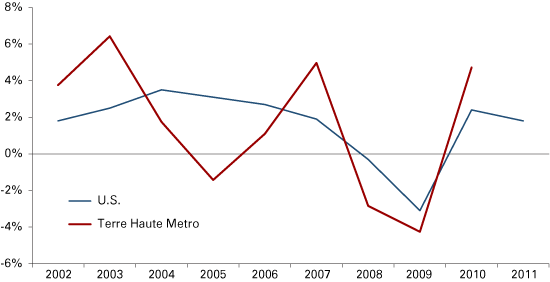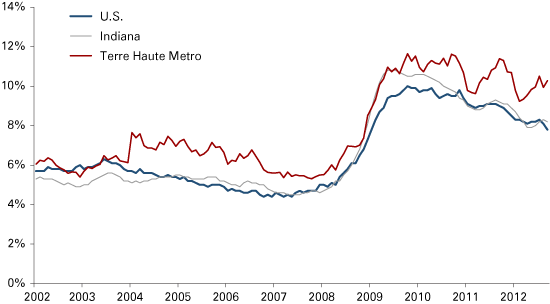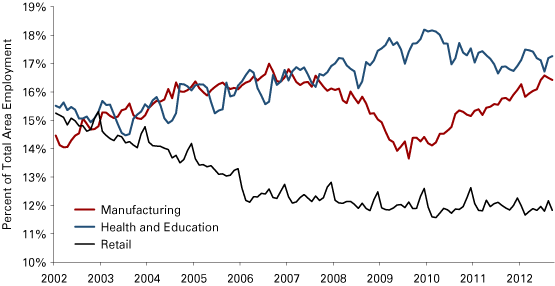Terre Haute Forecast 2013
Professor of Economics, Indiana State University
Associate Professor of Economics, Rose-Hulman Institute of Technology
The Terre Haute regional economy is struggling to generate a rate of growth above “stall speed.” The unemployment rate remains stubbornly high, and history suggests that unless the national economy grows more than 2.5 percent, the Terre Haute regional unemployment rate is unlikely to fall. Unfortunately, consensus forecasts for national economic growth are just in the 2.5 percent range, and the downside risks currently seem greater than the upside potential. Hence, the outlook for the Terre Haute regional economy remains much as it was last year: weak and susceptible to outside shocks.
If the national economy were to slip into recession, whether as a result of a failure to avoid the “fiscal cliff” or because of global disruptions in Europe or China, such a decline would constitute the third dip in output for the local economy since 2004. As can be seen in Figure 1, the Terre Haute metropolitan area experienced its first dip when Pfizer announced its departure, and experienced a second, more dramatic downturn in 2008, along with the rest of the country. Since that second downturn, total output of the local economy, measured by inflation-adjusted gross domestic product (GDP) for the metropolitan area had barely regained its pre-2008 levels by 2010. Another setback at this stage could be troubling indeed.
Figure 1: Real GDP Growth Rates, National Economy and Terre Haute Metro, 2002 to 2011

Source: Bureau of Economic Analysis
As one would expect, the employment picture remains clouded. As can be seen in Figure 2, even though unemployment rates in Terre Haute were higher than national and state rates during the expansion between 2002 and 2007, they were at relatively low levels in the 5 percent to 6 percent range as the recession began. As the recession deepened, unemployment quickly spiked in Terre Haute as it did elsewhere, peaking well above the national 10 percent peak (in seasonally adjusted terms). Though the recovery has lowered the national and state rates, Terre Haute’s unemployment rate remains about 2 percentage points higher than state and national rates. In short, the recovery has simply not been sufficiently robust to produce the jobs necessary to significantly reduce the local unemployment rate. Moreover, there are 5,000 fewer jobs in the area than there were a decade ago with a labor force that is approximately the same size (about 80,000).
Figure 2: Seasonally Adjusted Unemployment Rates, January 2002 to September 2012

Source: Bureau of Labor Statistics and authors’ calculations
Furthermore, the sectoral composition of jobs in Terre Haute has also changed in notable ways over the decade. Collectively, manufacturing, retail, and health and education have consistently accounted for about 45 percent of area employment. As Figure 3 shows, in 2002 these three sectors were equally important sources of area employment. In 2012, while still accounting for about the same level of employment collectively, the composition has changed significantly—with retailing becoming relatively less important. Terre Haute’s historic position as a regional shopping hub may continue, but as a source of employment, the retail sector’s prominence in the region has been sharply curtailed. Whether that is because shoppers are headed to their computers or to other cities we do not know, but one thing is clear: in terms of regional employment, retailing is no longer as important as it once was.
Figure 3: Share of Terre Haute Regional Employment, Selected Sectors, January 2002 to September 2012

Source: Bureau of Labor Statistics and authors’ calculations
On the plus side, Figure 3 also highlights the fact that manufacturing employment has actually recovered quite well since the low point of the most recent recession in late 2009 and anecdotal evidence supports this conclusion. Major area employers are beginning to step up employment. For example, Sony DADC is taking steps to broaden the appeal of its Blu-Ray DVDs. This is allowing Sony to increase sales. As a result, hiring (albeit temporary hiring) has increased employment at Sony.
Expansion by some of Terre Haute’s other major employers is also contributing to a modest rebound. Alorica has continued to expand both its client base as well as its employment prospects for its call center operation on the north side of the city. In February, Eli Lilly acquired ChemGen, a Maryland animal science company. Prospects are good that this will result in greater opportunities for Terre Haute’s production facility. In March, Bemis announced plans to create 40 new positions in Terre Haute as part of a consolidation of production at other facilities, and in April ThyssenKrupp Presta announced plans to add 120 workers as a result of a $22 million expansion. ADVICS (formerly Aisin Brake and Chassis) has invested heavily in its Terre Haute facility, adding 135 new jobs in two years. Though disappointed to see its joint strike-fighter engine opportunities disappear, Unison continues to add jobs in Terre Haute for its GEnx engine parts manufacturing. Finally, Applied Extrusion Technologies is adding equipment and employees to “metalize” its oriented polypropylene packaging materials.
In terms of new investments by companies new to the region, Menard’s is building a distribution center in Terre Haute for block, trusses and lumber. The $12 million facility will employ 80 people. The year’s most significant economic news in the city was that the old Pfizer facility will soon see a new occupant. Transferred to the Vigo County Redevelopment Commission when Pfizer ceased operations on the south side of the city, the facility was sold in April to NantWorks, a California-based pharmaceutical manufacturing company. Contingent upon FDA approval, the company plans to produce critical-care injectable drugs and oncological drugs on the site, with the expectations of eventually creating more than 200 new high-wage positions. Such a development would represent a significant infusion of new investment and jobs into the community.
Outlook
However hopeful these investments may make us, Terre Haute’s near-term economic future remains cloudy. The area’s institutions of higher education have, on net, growing enrollments and stable employment. The area’s hospitals and other health care providers remain important sources of good employment in the city. Neither of these sectors appears threatened, although neither appears poised for significant expansion.
While Terre Haute’s manufacturing base has recovered nicely since the recession, recent history demonstrates that such growth is susceptible to adverse shocks in the national and global economy. These two sectors collectively account for about 34 percent of area employment and 43 percent of private sector output. One is stable, while the other is regaining strength but subject to national and global economic headwinds.
In terms of long-term economic prospects, the picture is also somewhat gloomy. The population of the area and its labor force have barely changed in the past decade, while the number of jobs has declined by more than 7 percent. This decline has been both secular and cyclical, creating a situation in which brain drain is a real problem. If the area is to provide meaningful employment to its residents in the future, new sources of employment must emerge. Outside investments of the scale NantWorks and ThyssenKrupp Presta are planning are of the type required for this to occur. The Terre Haute Economic Development Corporation’s efforts in this area are laudable, but even assuming a large employment multiplier, it will take several more such investments for the region to regenerate the 5,000 jobs lost in the last decade. Unless and until more new investments occur, Terre Haute’s prospects will remain modest.
Also in this Issue…
- International Outlook for 2013
- U.S. Outlook for 2013
- Financial Outlook for 2013
- Indiana's Outlook for 2013
- Indiana's Agricultural Outlook for 2013
- Three Key Indicators—Forecasts for Jobs, Income and Productivity
- Anderson Forecast 2013
- Bloomington Forecast 2013
- Columbus Forecast 2013
- Evansville Forecast 2013
- Fort Wayne Forecast 2013
- Gary Forecast 2013
- Indianapolis-Carmel Forecast 2013
- Lafayette Forecast 2013
- Louisville Forecast 2013
- Muncie Forecast 2013
- Richmond Forecast 2013
- South Bend and Elkhart Area Forecast 2013
- Terre Haute Forecast 2013




